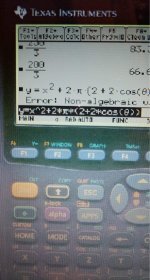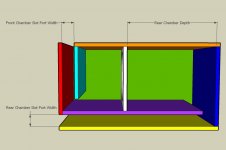Top of BW is screaming
Yeah, both my default series and parallel sims look more like one of those ROARs than BP 6 sims as both 'get up on the pipe' [2 stroke racing jargon] around 80 Hz out to ~220 Hz except under damped [no stuffing] down to its ~26 Hz Fp [series] whereas parallel was a ~ 33 Hz Fp 'one note' 150 Hz/+20 dB peak.
Super low Vas drivers suck for vented alignments, so need multiples to get a good sim/performer without excessive EQ. That said, great for designing a large speaker, then built as stackable single/dual/whatever driver modules that can be EQ'd to work as singles as Danley, et al are doing nowadays and what I plan to do if I'm ever involved again with another HIFI/HT multiple sub-woofer array.
Last edited:
‘On the pipe!!!’ 😀 that, for me often meant i looped it and landed on my butt.
Regarding the multiples: Friday, i ordered a second driver pair to double up on each current rss265/ho4 for the reasons you said.(spread out) .
And a big dumb ultimax 15(clearance/iOpen box) was there to insist i buy It to off below 20hz in MLTL i suppose.
Regarding the multiples: Friday, i ordered a second driver pair to double up on each current rss265/ho4 for the reasons you said.(spread out) .
And a big dumb ultimax 15(clearance/iOpen box) was there to insist i buy It to off below 20hz in MLTL i suppose.
How about this?
Yeah, a TH is what I'd do, but it wasn't what he's interested in. 🙁
I like taking random HR txt files for either 12” of 18”
Drivers and adapting the to work with mine(the man one i used for labrat).
the things are pretty well diverse if i just payatention to the damped or undamped response of a known successful cabinet. Theyre anke to usually settle into a similar looking result by only an early CSA change and minimal use of stuffing to gage the likelyhood of any similar real results.
one thing over and over became clear, and trying to ‘prove’ it is just a waste of time building cabinets to compromise it to see. even buying slug pistons to drive a pipe into deep mud, lol? But this is getting expensive and im
Piling up the old for the next before theres stillAnother on the workbench. Thats now also got one on the router table.
The stepped pipe with a pipe connected directly to it at exit (the driver entry at each far end of those. and thus the distance between them to a center is also a fold. Its all broken down into the lesser pipes dimension.
the sum of which is the drawn as the frequency of length in each of those creates a mark at 90 degrees on a circles circumference.
If i rotate that circle around and around as its a sine wave represented as the
Degrees or radians(1,2pi is 360/720). This on a polar plot to the 13/4 harmonic in distance tracks like pressure phase in anything.
That is me describing the way to fold that idea if representing it. its 80 or 100 cm. For an Fs/Fb as needed. Easy for me to use in what ive got.
But iys two pipes as 300 and 100. Rolled out as i described i end up with a shape for that sine wave all the way from 1200cm to zero and plot it. Connecting the 90 degree landing spot as it touches the other circle its rolling along leaving the mark.
is that shape of any significance to the sound signature? Or a hInt that it could be? That shape is eventually a cardoid shape. Plottted to imfinity(sorta). But its well represented in a certain shape thats also hard to actually achieve those lengths in the 3 parts /100cm x 3 is the long pipe folded) and the one of other.(100cm not folded).
I hate math. But its hard to draw too . But i cheat and borrow ideas from smart people. (0.349) is about 90 degrees just gotta spin the the circles to see in calculus or whatever..? Here it is(again),?
Drivers and adapting the to work with mine(the man one i used for labrat).
the things are pretty well diverse if i just payatention to the damped or undamped response of a known successful cabinet. Theyre anke to usually settle into a similar looking result by only an early CSA change and minimal use of stuffing to gage the likelyhood of any similar real results.
one thing over and over became clear, and trying to ‘prove’ it is just a waste of time building cabinets to compromise it to see. even buying slug pistons to drive a pipe into deep mud, lol? But this is getting expensive and im
Piling up the old for the next before theres stillAnother on the workbench. Thats now also got one on the router table.
The stepped pipe with a pipe connected directly to it at exit (the driver entry at each far end of those. and thus the distance between them to a center is also a fold. Its all broken down into the lesser pipes dimension.
the sum of which is the drawn as the frequency of length in each of those creates a mark at 90 degrees on a circles circumference.
If i rotate that circle around and around as its a sine wave represented as the
Degrees or radians(1,2pi is 360/720). This on a polar plot to the 13/4 harmonic in distance tracks like pressure phase in anything.
That is me describing the way to fold that idea if representing it. its 80 or 100 cm. For an Fs/Fb as needed. Easy for me to use in what ive got.
But iys two pipes as 300 and 100. Rolled out as i described i end up with a shape for that sine wave all the way from 1200cm to zero and plot it. Connecting the 90 degree landing spot as it touches the other circle its rolling along leaving the mark.
is that shape of any significance to the sound signature? Or a hInt that it could be? That shape is eventually a cardoid shape. Plottted to imfinity(sorta). But its well represented in a certain shape thats also hard to actually achieve those lengths in the 3 parts /100cm x 3 is the long pipe folded) and the one of other.(100cm not folded).
I hate math. But its hard to draw too . But i cheat and borrow ideas from smart people. (0.349) is about 90 degrees just gotta spin the the circles to see in calculus or whatever..? Here it is(again),?
Attachments
Last edited:
Fixed!Your link doesn't work, you put a link in a link. 🙁
All you needed to post is this:
12TBX100 LF Drivers - B&C Speakers
Interesting! FWIW HR limits power to ~378 W/9 mm Xmax.
What are the lengths? I just used 20 cm, the min. distance to back wall based on driver depth.
Basic default 34 Hz TH [end loaded] and 34 Hz DTS [1/4 WL stub TH]:
Sorry, none of the text files you attached in these repiles can be opened...
Unfortunately none of the files opening dear...Yeah, im not sure i ever was able to describe what i thought you were . I dunno if you can look but GM(Greg) has broken it up into pieces (20cm portions) and i previously did 40 (same thing essentially but squares to cubes in youre chambers) to mimic all dimensions as they would fit as drawn. But a port area and the details or your ‘exit and lengths apart’ as well as 90 degrees vs 180 degrees were important ? Have a go at plugging it all in from the txt file. The speaker Jedi has constructed 🙂
How do I figure out dimensions before the simming part???Right, without dims, can't set the path length [delay], so used 0, though ~200 cm is the flattest response over widest BW, but requires significant EQ to be of any use.
I found this on the Internet, PARALLEL 6TH ORDER BANDPASS (OFF-AXIS as opposed to mine), but very similar???Yeah, as 40 cm it still just created a tall skinny rippled two bump if trying to get at what the pics appeared to be conveying. Though what he had was almost exactly where this is in Isobaric
rF p3 d2
Sd
570
Re3.2 Le 4
Vas 57
fs 26
Qes .53
Qms 6.7
Xmsx 13
Pfms 600
Chambers are 48 liters and 300 cm2 wraps around at 240 cm length as the vent is just rear chamber fof an excuse to play with cone control and stuffing
I Cant really get a tbx to work where the other TS parameters above almost do alright in the shape as it appears(abbreviated the short side port to nearly nothing but open rear chamber volume at 1200cm2... x 40 cm.
Attachments
Do you actually mean the 6TH ORDER BANDPASS as a concept fails or the particular design I sketched would fail (I'm.confused)? 😕Yeah, both my default series and parallel sims look more like one of those ROARs than BP 6 sims as both 'get up on the pipe' [2 stroke racing jargon] around 80 Hz out to ~220 Hz except under damped [no stuffing] down to its ~26 Hz Fp [series] whereas parallel was a ~ 33 Hz Fp 'one note' 150 Hz/+20 dB peak.
Super low Vas drivers suck for vented alignments, so need multiples to get a good sim/performer without excessive EQ. That said, great for designing a large speaker, then built as stackable single/dual/whatever driver modules that can be EQ'd to work as singles as Danley, et al are doing nowadays and what I plan to do if I'm ever involved again with another HIFI/HT multiple sub-woofer array.
It's quite impressive to see that simple enclosure being able to achieve both 20hz and 110db simultaneously.How about this?

But, it looks like a tapped horn reversed (inward-radiated), what's the science behind that?
Do you mean I'm not interested in any other type?Yeah, a TH is what I'd do, but it wasn't what he's interested in. 🙁
Wait, 90*??? 90 multiplied???Why would you have 1 port firing 90* away from the other port?
Ah, okay okay, if you meant 90° (degrees) away, that's how "PARALLEL" 6TH ORDER BANDPASS usually is.
Last edited:
Unfortunately none of the files opening dear...
Those are inputs for 2 complete sims in horn response you can download it and plug and chug awAy.
Ah thanks dear! I'll check... 😀Those are inputs for 2 complete sims in horn response you can download it and plug and chug awAy.
- Home
- Loudspeakers
- Subwoofers
- How about this...?



